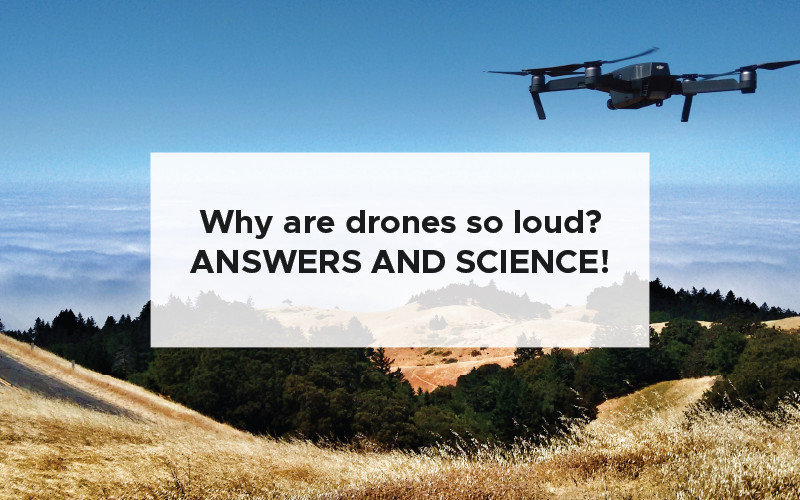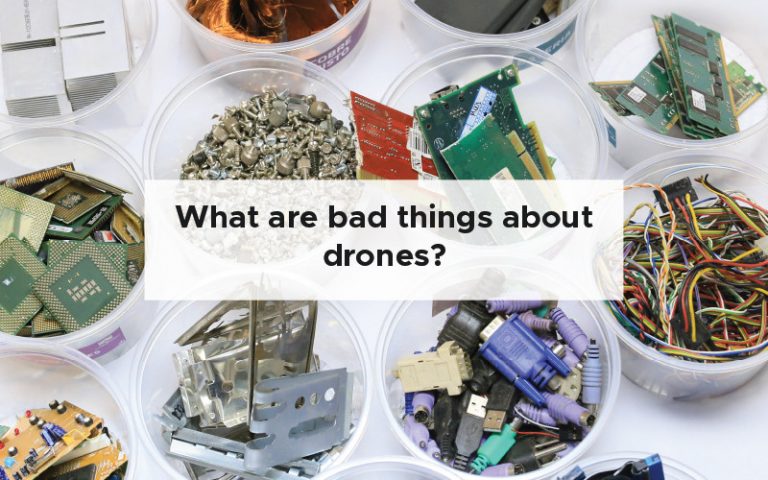There are many positive things about drones and quadcopters. They are a technological advancement that has a great potential for improving things like live organ delivery, security, surveying and asset management, and much more. However, like other bits of technology, the introduction of drones has also created some downsides. In this article, we’re going to go over the bad things about drones and what negative effects drones might cause in the near future.
The negative effects of drones include increased urban noise, decreased privacy, injury and property damage during drone flight and crashes, and the increase of environmental waste that inevitably results from new battery technologies and upgradeable gadgets.
Even though the majority of drone flyers and owners do the right thing it only takes a handful of inconsiderate drone pilots to completely ruin the drone flying experience for the majority.

“A lot of people won’t find much to worry about, but there are potential problems that happen when technology is adopted in an unchecked fashion”
— Dr Michael Richardson
For example, flying drones near wildlife or near people can result in extra legislation and rules and regulations which are prohibitive to those who fly drones recreationally.
The drone rules and regulations have adapted quickly to the onset of commercially available drones and a lot of the policies have been a knee-jerk reaction to issues and problems which people have seen or considered whilst drafting legislation.
There is no excuse for not following the drone regulations and laws in your country but we know that there are a ton of drone pilots that are constantly breaking laws in the name of “getting the perfect shot” or fun and adventure.
The negative side effects of drone technology are not just limited to bad drone pilots either.
With our increased consumer consumption of electronic items, drones will contribute to the 53.6 million metric tons of e-waste which is generated globally each year. In fact, the fate of 62.6% of e-waste is uncertain and is either incinerated, ends up in landfills, is stored in households, or recycled in informal operations. Given that you are probably thinking about upgrading your drone this may give you pause for thought.

Here, other bad things about flying drones that you may not have considered.
The bad things about drones
The bad things about drones include increased noise, reduction of privacy, injury caused by blade spinning at over 5000 revolutions per minute, property damage and also environmental waste, as we’ve talked about above.
Noise
There is no doubt that drones are noisy. If you want to know about why drones are so loud check out my other article – why are drones so loud? [Full answers from science] – click here.

Ultimately, drones are incredibly loud because the propellers are rapidly moving through the air displacing molecules which introduce pressure spikes and drops as the propeller spins. This creates the signature buzzing noise that we are familiar with when a drone is flying overhead.
Drones vary in their noise volume depending on a number of factors such as the propeller with the number of times per minute that the propeller is rotating as well as how close it is to you. A fountain for pro, a Mavic air, a DJI Mavic pro, and a DJI spark series drone are all between 70 and 80 dB in volume. That is somewhere between a washing machine working all the way up until a morning alarm clock.
Prolonged exposure to noise above 85 dB will result in hearing damage.
Since drones have been viewed as a method of delivery in urban settings, air congestion caused by the advancement and uptake of drones as delivery agents could result in an increase in urban noise pollution.
Luckily, there are ways to make drones quieter such as absorbing the same generated, using more propellers that rotate lower, or using low noise propellers.
Privacy
One of the first security considerations that people thought of when sending a camera into the sky is the impact of drone technology on privacy of individuals and corporations.
A lot of drones have cameras attached and the piloting rules mean that you should stay approximately 30 m away from people and property. At this distance it is not likely that you will be able to be identified unless your drone has a particularly good sensor and camera.
Some actions by drone operators can be considered criminal offences. For example, in Queensland, Australia, it is illegal to record somebody without their consent if they are in a private place or conducting a private act. This means that if you are flying over their house and you happen to capture them in their garden it may be considered a private place.
Drones can also fly over areas which can be considered trespassing. A trespassing involves the interference with your rights to private enjoyment to land which means that your house and land around it are protected from drone flight.
The ongoing cat and mouse game between drone technology and legal precedent will no doubt continue into the future. But there is no doubt that flying a drone to capture somebody in a private location without their consent is certainly an infringement on privacy. Pretty much every law-making country agrees on this one fact.
Injury during flight
Drones can also cause injury when they come into contact with people, property, or wildlife during their flight. They can also cause injury if the worst were to happen, and the drone were to drop out of the sky and land on a person.
Some personal injuries caused by drones include:
- loss of an eye – in 2015 an English toddler lost his eye when it was sliced open by a drone propeller after the operator lost control of the drone.
- Facial lacerations – in California a drone had an 11 month year old girl while she was in her stroller. The drone cut her face.
- Physical and emotional injuries – in 2016 two wedding guests filed a lawsuit against the hosts of the wedding in North Carolina. This is because the drone crashed into them during the reception which caused them alleged physical and emotional injuries.
It seems like the eyes are a particularly vulnerable area to drone injuries since the propeller can slice them open and cause significant damage should the propeller come into contact with the surface of the eye.
Personal injury
In my other article – can a drone cut your finger off? Videos from experiments I go through all of the video evidence of drone injuries and damage to soft parts of your body.
In short, there is plenty of evidence that a drone can cause significant damage to the soft parts of your body which is most likely your hand or finger. However, it simply doesn’t have enough power to get through the bone.
There have been a number of experiments with commercial and professional drones but none of them have been able to take off a finger.
Researchers from Aalborg University in Denmark have been testing the damage caused by a range of propellers. They have been using them to cause a range of damage to pork (as it is one of the closest things to human muscle and skin). They also took the propellers to other materials like glass and cars too… all in the name of science!
The researchers strapped a large slab of pork to the end of a ramp. The ramp was used to fire the blades towards the meat and contained the blades spinning at precisely controlled RPMs. The actual catapult is nearly three meters long and built of aluminum. The slide is pulled by an electric motor. It can accelerate a 1-kilogram drone up to 15 meters per second and the collision is filmed with a high-speed camera with over 3000 frames per second. The force of impact is measured over time as this is important for the extent of the injury. Once the researchers get more experienced, the plan is to upgrade the catapult for larger drones and higher speeds.
Here’s some fascinating super slow mo of plastic blades hitting the meat:
The scientists discovered that plastic blades shatter pretty much on impact while carbon fibre blades (known for their strength) can do a lot more damage. These were only the beginnings of a research study and they are planning on working more with hospitals as drone injuries become a more common occurrence.
My personal experience
In my personal experience with drone injuries, my finger was caught in a Mavic air drone propeller when I was attempting to catch my drone during landing:
My experience with my drone injury was three fold:
- The bruising from the injury was worse than the cuts that I got.
- It was no worse than the time I took off the top of my finger with a cheese grater
- It was all healed up after two weeks with no lasting scarring – just a lesson learned!
From my research online this is my understand of most people’s experience with drone injuries and still no evidence that it could take off your finger in any sense.
Property damage
Not only could a drone cause personal injury but it can also cause damage to property.
Because drones are relatively light is unlikely to cause significant damage to anything like a car or a house. However, if the drone was to get close to an aerial, or other extraneous part of a house it could damage that component beyond the point of repair.
Even though the blades are relatively light, when they are spinning at a very high number of revolutions per minute they can easily cause damage to property.
Also, a drone falling out of the sky uncontrolled at a weight of greater than 2.5 kg can easily cause a significant amount of damage to the person it is landing on all the property that it has come in contact to during an uncontrolled landing.
Environmental waste
Lastly, one of the bad things about any new consumer product is the amount of waste generated when demand for an electronic product increases.
Each year, up to 53.6 million metric tons of e-waste is produced and is increasing by more than 20% over the five year periods. Without proper recycling there is no doubt that e-waste can contribute to a significant amount of landfill – and landfill which has the potential to be highly toxic.
In many parts of the world there is a lack of recycling infrastructure to handle electronic waste in general.
Asia generated the highest quantity of e-waste in 2019 at 24.9 million tons with a formal collection and recycling rate of only 11.7%.

No study has been done to work out how much of this waste is from drone usage but there is no doubt that drones can be added to that amount of e-waste. With companies like DJI and parrot and Autel coming up with new drones every couple of years there is no doubt that drone e-waste will increase over the coming years.
Are drones bad for the environment?
Drones are bad for the environment in two ways. First of all, the lithium polymer batteries and the metals which are used in the construction of drones need to be recycled. And secondly, the plastics that are used in drone technology for the airframe and other components also needs to be able to be recycled.
Lithium polymer batteries
In a 2016 study, lithium polymer batteries made up about 17.6% of the market share.
This study also highlights that the way to recycle lithium polymer batteries is by using a Pirometalurgical approach as well as a Hydrometalurgical approach. A number of different countries have developed systems for using these two recycle the lithium polymer batteries.
This means that they are recovering the lithium in these batteries by using fire and water to dissolve away or separate the recyclable components from things like plastic which is commonly used as a substrate for circuit boards.
Plastic
As the demand for drones increases the amount of plastic that the drone is shedding in terms of accessories and propellers is also increasing. The good news is that in 2018 a study was published which looked at the feasibility of using recycled plastics from bottles such as PET as a 3D printing filament.
This means that the body of the drone may be able to be recycled using 3D printing. The material used in the study offered a low-cost way of reusing recycled plastic and making a drone airframe which can withstand showering and splashes of water as well as being capable of withstanding the strain and stresses of flight.
Negative impact of drones on environment
As technology improves and we are able to capture more of the recyclable material from electronic components and lithium polymer batteries the negative impact of drones on the environment will be minimised.
However, until that time there is the potential for a serious negative impact of drones on the environment. It relies on all of us taking charge of recycling our drone batteries effectively whilst also being environmentally conscious while disposing of our old drones.
How do I dispose of drone batteries?
Dispose of the battery into specific recycling boxes only after a complete discharge. Do not place the battery into regular rubbish bins. Strictly follow your local disposal and recycling regulations of batteries.
If the power on/off button of the Intelligent Flight Battery is disabled and the battery cannot be fully discharged, please contact a professional battery disposal/recycling agent for further assistance.
Negative effects of drones – What problems drones might cause?
Looking forward to the future if drones become a significant part of our environment there are a number of negative effects that drones could cause.
For example:
- Stopping birds from nesting – drones could stop birds from nesting and interrupting feeding of birds while they are trying to nest. For more information check out my other article where I go through the full process of protecting birds and your drone simultaneously.
- Increased urban noise – with more drones in the sky there is no doubt there is a high potential for increased urban noise. As long as drone technology advances to the point where drones are relatively quiet through the use of new technological advances and new sound absorbing materials it shouldn’t get too bad.
- Pollution in developing countries – recycling our electronic components often happens in developing countries. As drones are seen more and more as a consumer product more and more old drones and electronic circuit boards will end up being sent to developing countries which could impact the ecosystem of the countries which burn the electronic components to get the precious metals.
- Unwanted surveillance – as drone technology is taking up more and more by governments and law enforcement there is a chance that there will be an increase in unwanted surveillance. The laws are being developed to protect individuals and governments but for law enforcement the level of privacy that they need to provide to protesters or other people being surveyed is still being negotiated.
Summary
In this article we went through all of the bad things about drones.
For the majority of drone photographers, videographers, and hobbyists as long as you abide by your local laws and regulations there is no need to worry too much about doing bad things with your drone. It is those people who are not following the laws and are purposely using their drone to cause mischief that cause issues for the majority of them are doing the right thing.
Drone technology has the potential to solve many of the world’s problems but also can cause issues when it comes to recycling the drone and making sure that the components do not have any ecological consequences for the countries that end up recycling these high-end electronic devices at the end of their life.




